Deficient activity in the neural systems that mediate self-regulatory control in bulimia nervosa
- PMID: 19124688
- PMCID: PMC2759684
- DOI: 10.1001/archgenpsychiatry.2008.504
Deficient activity in the neural systems that mediate self-regulatory control in bulimia nervosa
Abstract
Context: Disturbances in neural systems that mediate voluntary self-regulatory processes may contribute to bulimia nervosa (BN) by releasing feeding behaviors from regulatory control.
Objective: To study the functional activity in neural circuits that subserve self-regulatory control in women with BN.
Design: We compared functional magnetic resonance imaging blood oxygenation level-dependent responses in patients with BN with healthy controls during performance of the Simon Spatial Incompatibility task.
Setting: University research institute.
Participants: Forty women: 20 patients with BN and 20 healthy control participants. Main Outcome Measure We used general linear modeling of Simon Spatial Incompatibility task-related activations to compare groups on their patterns of brain activation associated with the successful or unsuccessful engagement of self-regulatory control.
Results: Patients with BN responded more impulsively and made more errors on the task than did healthy controls; patients with the most severe symptoms made the most errors. During correct responding on incongruent trials, patients failed to activate frontostriatal circuits to the same degree as healthy controls in the left inferolateral prefrontal cortex (Brodmann area [BA] 45), bilateral inferior frontal gyrus (BA 44), lenticular and caudate nuclei, and anterior cingulate cortex (BA 24/32). Patients activated the dorsal anterior cingulate cortex (BA 32) more when making errors than when responding correctly. In contrast, healthy participants activated the anterior cingulate cortex more during correct than incorrect responses, and they activated the striatum more when responding incorrectly, likely reflecting an automatic response tendency that, in the absence of concomitant anterior cingulate cortex activity, produced incorrect responses.
Conclusions: Self-regulatory processes are impaired in women with BN, likely because of their failure to engage frontostriatal circuits appropriately. These findings enhance our understanding of the pathogenesis of BN by pointing to functional abnormalities within a neural system that subserves self-regulatory control, which may contribute to binge eating and other impulsive behaviors in women with BN.
Figures
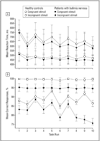

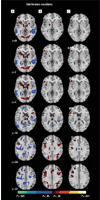
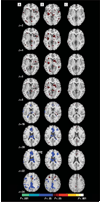

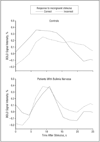
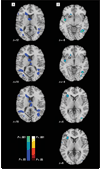
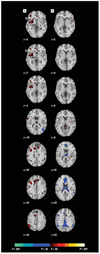
Similar articles
-
An FMRI study of self-regulatory control and conflict resolution in adolescents with bulimia nervosa.Am J Psychiatry. 2011 Nov;168(11):1210-20. doi: 10.1176/appi.ajp.2011.11010094. Epub 2011 Jun 15. Am J Psychiatry. 2011. PMID: 21676991 Free PMC article.
-
A developmental fMRI study of self-regulatory control in Tourette's syndrome.Am J Psychiatry. 2007 Jun;164(6):955-66. doi: 10.1176/ajp.2007.164.6.955. Am J Psychiatry. 2007. PMID: 17541057 Free PMC article.
-
An FMRI study of frontostriatal circuits during the inhibition of eye blinking in persons with Tourette syndrome.Am J Psychiatry. 2010 Mar;167(3):341-9. doi: 10.1176/appi.ajp.2009.08121831. Epub 2010 Jan 15. Am J Psychiatry. 2010. PMID: 20080981 Free PMC article.
-
[Structural and functional neuroanatomy of attention-deficit hyperactivity disorder (ADHD)].Encephale. 2009 Apr;35(2):107-14. doi: 10.1016/j.encep.2008.01.005. Epub 2008 Jul 7. Encephale. 2009. PMID: 19393378 Review. French.
-
Functional disturbances within frontostriatal circuits across multiple childhood psychopathologies.Am J Psychiatry. 2009 Jun;166(6):664-74. doi: 10.1176/appi.ajp.2009.08091354. Epub 2009 May 15. Am J Psychiatry. 2009. PMID: 19448188 Free PMC article. Review.
Cited by
-
Does a shared neurobiology for foods and drugs of abuse contribute to extremes of food ingestion in anorexia and bulimia nervosa?Biol Psychiatry. 2013 May 1;73(9):836-42. doi: 10.1016/j.biopsych.2013.01.002. Epub 2013 Feb 4. Biol Psychiatry. 2013. PMID: 23380716 Free PMC article. Review.
-
Maturation of Brain Microstructure and Metabolism Associates with Increased Capacity for Self-Regulation during the Transition from Childhood to Adolescence.J Neurosci. 2019 Oct 16;39(42):8362-8375. doi: 10.1523/JNEUROSCI.2422-18.2019. Epub 2019 Aug 23. J Neurosci. 2019. PMID: 31444243 Free PMC article.
-
Satiety does not alter the ventral striatum's response to immediate reward in bulimia nervosa.J Abnorm Psychol. 2021 Nov;130(8):862-874. doi: 10.1037/abn0000712. J Abnorm Psychol. 2021. PMID: 34843290 Free PMC article.
-
Annual research review: The neurobehavioral development of multiple memory systems--implications for childhood and adolescent psychiatric disorders.J Child Psychol Psychiatry. 2014 Jun;55(6):582-610. doi: 10.1111/jcpp.12169. Epub 2013 Nov 29. J Child Psychol Psychiatry. 2014. PMID: 24286520 Free PMC article. Review.
-
Alterations of interhemispheric functional homotopic connectivity and corpus callosum microstructure in bulimia nervosa.Quant Imaging Med Surg. 2023 Oct 1;13(10):7077-7091. doi: 10.21037/qims-23-18. Epub 2023 Sep 19. Quant Imaging Med Surg. 2023. PMID: 37869275 Free PMC article.
References
-
- Klein DA, Walsh BT. Eating disorders. Int Rev Psychiatry. 2003;15(3):205–216. - PubMed
-
- Kaye W, Strober M, Jimerson DC. The neurobiology of eating disorders. In: Charney D, Nestler EJ, editors. The Neurobiology of Mental Illness. New York, NY: Oxford Press; 2004. pp. 1112–1128.
-
- Baumeister RF, Vohs KD. Handbook of Self Regulation. New York, NY: Guilford Press; 2004.
-
- Simon JR. Reactions toward the source of stimulation. J Exp Psychol. 1969;81(1):174–176. - PubMed
-
- Peterson BS, Kane MJ, Alexander GM, Lacadie C, Skudlarski P, Leung HC, May J, Gore JC. An event-related functional MRI study comparing interference effects in the Simon and Stroop tasks. Brain Res Cogn Brain Res. 2002;13(3):427–440. - PubMed
Publication types
MeSH terms
Substances
Grants and funding
LinkOut - more resources
Full Text Sources
Other Literature Sources
Medical
Molecular Biology Databases

